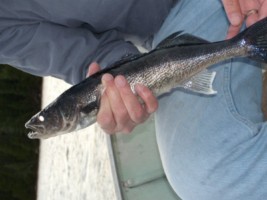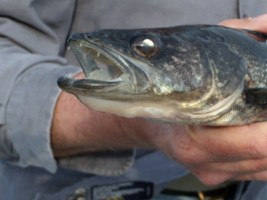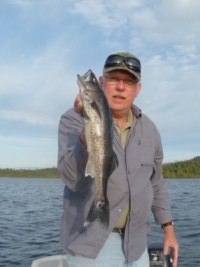Is it a Walleye?
Category: article
Jun 18th, 2010 by OutdoorsFIRST
Modified Jun 18th, 2010 at 12:00 AM
Is it a Walleye? Is it a New Species? Is it a Sub-Species? Fisheries researchers will answer these questions with DNA. Right now, the world’s foremost scientists are pouring over DNA samples, and Dieter Busch, a semi-retired Fish and Wildlife Service biologist who still digs into the status of the fish affectionately called, “Blue Pike” helped us understand even more.
 |
|
Dieter now lives in Delaware, but worked for years in the New York offices along the Great Lakes, with the Blues on his mind. Some call it “Blue Walleye,” but only recently. Ever since the heydays of the 1930’s and 1940’s, fishermen and diners called them “Blue Pike.”
These personal inquiries started following a trip from Brainerd, Minnesota, to Pasha Lake Cabins north of Thunder Bay, Ontario in mid-May. I was with friend Pastor Mark Boone, and we were fortunate to be in a camp with Adventure-style fishing. The adventure wasn’t so much the fishing – that was a given – but getting to lakes so far back in the bush they seldom saw a Husky Jerk or a FireBall jig.
We experienced some tremendous, remote fishing action, catching big pike and numerous walleyes. Even some giant perch gobbled up our jigs. Then, one evening, rigging minnows on a deep break, a strange and dark fish came to net. It had all the trappings of a walleye with the exception of color. It was gray and blue with some iridescent greens sparkling in the setting sun. We took a picture and released it. Back at camp, we asked owner Chad ([email protected], 866-333-5943, or [email protected]) about it. He said quite a few customers have caught Blue Pike in Northwind Lake.
That’s when it hit us: We actually caught a Blue Pike. There were stories in In-Fisherman, but mostly from an historical standpoint. The more we realized what we had, the more the uniqueness hit us, and a few days later decided to try Northwind again. Could we catch another one? In a 14-foot boat with a Merc 9.9 and a Vexilar with a transom transducer affixed via a suction-cupped board, we were in search mode. The water was cold, and walleyes were holding over old weeds, mostly less than 7-feet deep. The day was spent jigging shallows. Walleyes to 22 inches were very active.
 |
|
|
Caption Title (Credits)
|
Towards the end of the day, we mapped out a couple of expansive reefs, and worked the outside depths in 16 to 22 feet. After marking fish and tossing a buoy, we circled back, deployed the drift sock, and began rigging. The walleyes were biting, and Pastor Mark set the hook. Another strange looking fish came to the net. It was a Blue Pike. A few minutes another Blue bit my bait, and we had two wrapped fish in the cooler ready for the taxidermist. Yes, we took many photos, which accompany this article.
The questions nagged, and after some research into old In-Fish articles, a glance at several books and a chat with Dieter himself, I learned some interesting facts. Blue Pike are currently “suspects,” according to Dieter. They are suspected of really being regular walleyes with a bluish mucous giving them the “Blue” moniker. They are suspected of being a separate sub-species of walleyes, and are also suspected of being a distinct species.
He said, “By the end of the year we’ll know if we have real blue pike. We have DNA of preserved specimens from years ago. We have skin of mounted fish and DNA of those that have apparently survived via man’s moving them as he traveled north. Those fish caught in your remote northern Ontario lake could be transplants from Lake Erie in the 1930’s.” Several lakes in the Nipissing region of Ontario and to the east in Quebec may contain fishable populations – survivors — of the millions of original Great Lakes Blue Pike.
 |
|
|
|
Blue Pike lived in the eastern basin of Lake Erie and western end of Lake Ontario. Dieter said, “Lake Erie became a city of lights with night fishermen catching Blue Pike. I think they came up in the water column with the bait fish.” In 1885, commercial netters brought 3,000,000 pounds into Michigan, Ohio, Pennsylvania and New York ports. In the 1950’s, the catches ranged from 2 to 26 million pounds. By 1959, the fishery collapsed with over-fishing and pollution the main culprits. It was labeled “extinct” by 1971.
Dieter said his extensive research and that of other biologists shows that Blue Pike exhibit some unusual characteristics from the traditional yellow walleye. For instance:
1. Blue Pike prefer colder water than yellow walleyes;
2. Blue Pike live much deeper than yellow walleyes;
3. Blue Pike seem to key on lake herring, a favorite of lake trout;
4. Blue Pike spawn as deep as 50 to 60 feet, with yellow walleyes spawning very shallow, seldom deeper than 14-feet;
5. Blue Pike growth usually maxes out in the 20-inch or slightly longer range; yellow walleyes grow well into the 30-inch range;
6. Blue Pike preferred summer habitat of the Lake Erie eastern basin, and almost never ventured to the western basin in the warm-weather months;
7. The book, “Freshwater Fishes of Canada” states that the Blues have a slower growth rate and different spawning time then yellow walleyes;
8. Years ago, it was considered a subspecies, Stizostedion v. glaucum, however a high frequency of inter-grades with yellow walleyes, caused a retraction of that classification. New research will determine where the Blues should be classified.
Dieter said, “They were so common, they were not considered a trophy. People
simply ate ’em.” They are now labeled extinct in Lake Erie. Dieter said it will never be known if fishing affected them or if another factor caused their demise. He said as rainbow smelt increased, Blue Pike decreased, which could have been the final nail in their coffin. “Luckily for us, it appears some fish were transplanted and survived, possibly like the fish you caught,” he said.
Walleyes come in many color phases including gray, green, golden, blue, and the traditional yellow. The Blues we caught had slate-blue almost transparent dorsal fins and appeared so distinct in color that it made us wonder if we had caught one of the few remaining specimens in the lake. That was not the case according to the locals; as plenty are caught annually to prove a viable population exists in Northwind Lake and several other Pasha Lake gems hidden in the bush, accessible via ATV. Biologists have determined that color alone is not good enough to create a new species. But, if a Blue Pike has the color and a distinct DNA composition, maybe it will receive its own star soon.
To catch your own Blue Pike, check with Chad at Pasha Lake Cabins. The camp gets my personal JK recommendation.